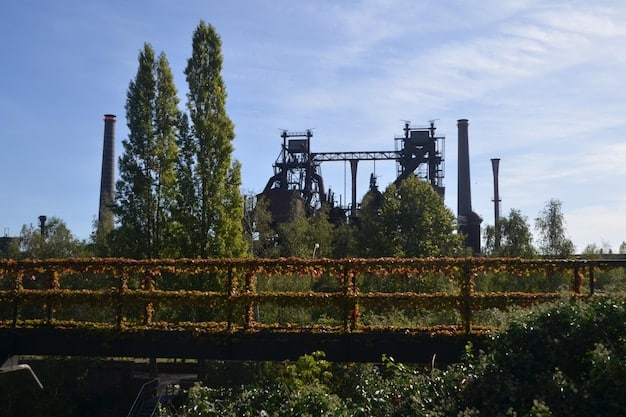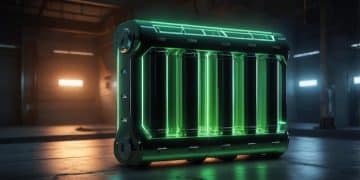Carbon Capture: Key to US Climate Goals by 2050?

Carbon capture and storage (CCS) technology is poised to play a significant, though complex, role in the US’s efforts to meet its ambitious climate goals by 2050, particularly in decarbonizing industrial sectors and power generation.
The United States has set ambitious goals to drastically reduce its carbon emissions by 2050. Central to achieving these targets is the widespread adoption of innovative technologies, and among these, carbon capture and storage (CCS) stands out as a potentially transformative solution. Understanding its role is vital for charting a sustainable energy future.
Understanding Carbon Capture and Storage (CCS)
To appreciate the potential impact of CCS, it’s essential to first understand what it is and how it works. CCS is a suite of technologies designed to prevent carbon dioxide (CO2) emissions from entering the atmosphere. This makes it a crucial tool in mitigating the effects of climate change, especially for industries that are difficult to decarbonize.
The Process of CCS
The CCS process consists of three main stages. First, CO2 is captured from industrial sources, such as power plants, cement factories, and steel mills. Then, the captured CO2 is compressed and transported, typically via pipelines, to a suitable storage site. Finally, the CO2 is injected deep underground into geological formations, where it is permanently stored and prevented from escaping into the atmosphere.
Different Methods of Carbon Capture
There are various methods for capturing CO2. Pre-combustion capture involves converting fuel into a mixture of hydrogen and CO2 before combustion. Post-combustion capture, on the other hand, removes CO2 from the flue gas after the fuel has been burned. Oxy-fuel combustion, another technique, involves burning fuel in pure oxygen, which produces a concentrated stream of CO2 that is easier to capture.
- Post-Combustion Capture: Captures CO2 from flue gases after combustion.
- Pre-Combustion Capture: Converts fuel into hydrogen and CO2 before combustion.
- Oxy-Fuel Combustion: Burns fuel in pure oxygen to produce a concentrated CO2 stream.
In summary, understanding CCS involves knowing its multi-stage process and the different methods available for capturing CO2, each suited for specific industrial applications. This technology is pivotal for sectors struggling to reduce emissions directly.

The Current State of CCS in the US
While CCS technology has been around for decades, its deployment in the US has been relatively limited. However, recent policy changes and increased investment are beginning to change this landscape. Several projects are underway across the country, aiming to demonstrate the viability and scalability of CCS.
Existing CCS Projects
Currently, the US has a handful of operational CCS facilities. One notable example is the Petra Nova project in Texas, which captures CO2 from a coal-fired power plant. Another significant project is the Illinois Industrial Carbon Capture and Storage Project, which captures CO2 from an ethanol plant and stores it underground.
Policy and Investment
Government policies and financial incentives play a critical role in driving the adoption of CCS. The US government has implemented various measures to support CCS, including tax credits, grants, and loan guarantees. The Inflation Reduction Act of 2022, for instance, significantly increased the tax credit for carbon capture, making it more economically attractive for companies to invest in CCS projects.
Challenges and Opportunities
Despite the growing momentum, CCS faces several challenges in the US. The high cost of implementation, the need for suitable storage sites, and public perception are among the key hurdles. However, there are also significant opportunities for CCS to contribute to the country’s climate goals, particularly in decarbonizing hard-to-abate sectors such as cement production and steel manufacturing.
- High Costs: Implementation costs can be substantial.
- Storage Capacity: Requires suitable geological storage sites.
- Public Perception: Public acceptance is crucial for project success.
The US CCS landscape is evolving, with projects underway and supportive policies in place, but challenges remain. Overcoming these hurdles is essential for unlocking the full potential of CCS in achieving climate goals.
Potential Contributions of CCS to US Climate Goals by 2050
As the US aims to achieve net-zero emissions by 2050, CCS could be a critical element in the strategy to reach this ambitious goal. By capturing and storing CO2 emissions from industrial facilities and power plants, CCS can significantly reduce the amount of greenhouse gases entering the atmosphere.
Decarbonizing Power Generation
Power plants are a major source of CO2 emissions in the US. CCS can be used to capture emissions from both coal-fired and natural gas-fired power plants, making them cleaner sources of electricity. This is particularly important for maintaining grid reliability as the country transitions to renewable energy sources.
Reducing Industrial Emissions
Industrial sectors such as cement, steel, and chemicals are also significant emitters of CO2. CCS can be deployed at these facilities to capture process emissions, which are often difficult to eliminate through other means. This can help these industries reduce their carbon footprint and remain competitive in a low-carbon economy.
Negative Emissions Technologies
In addition to capturing emissions from existing sources, CCS can also be used in conjunction with bioenergy to create negative emissions technologies. Bioenergy with carbon capture and storage (BECCS) involves growing biomass, burning it for energy, and then capturing and storing the resulting CO2 emissions. This effectively removes CO2 from the atmosphere, helping to offset emissions from other sectors.
- Power Generation: Cleans up coal and natural gas power plants.
- Industrial Emissions: Captures emissions from cement, steel, and chemical plants.
- BECCS: Combines bioenergy with CCS for removing CO2 from the atmosphere.
CCS has the potential to significantly aid the US in meeting its climate goals by decarbonizing power generation and reducing industrial emissions. Furthermore, CCS technologies could even help the country achieve negative emissions. The technology needs to be adopted at scale in these core areas to be effective.
Economic Considerations of CCS Implementation
The economic viability of CCS is a critical factor in determining its widespread adoption in the US. The costs associated with CCS projects can be substantial, but these costs need to be weighed against the benefits of reducing carbon emissions and mitigating climate change. Understanding the economic considerations is essential for policymakers, businesses, and investors.
Capital and Operational Costs
The capital costs of building CCS facilities, including capture equipment, pipelines, and storage infrastructure, can be significant. In addition, there are ongoing operational costs associated with running these facilities, such as energy consumption and maintenance. These costs can vary depending on the type of facility, the capture method used, and the location of the storage site.
Government Incentives and Carbon Pricing
Government incentives, such as tax credits and grants, can help to offset the costs of CCS projects and make them more economically attractive. Carbon pricing mechanisms, such as carbon taxes or cap-and-trade systems, can also incentivize CCS by putting a price on carbon emissions and making it more expensive to release CO2 into the atmosphere.
Job Creation and Economic Growth
The development and deployment of CCS technology can also create jobs and stimulate economic growth. CCS projects require skilled workers to design, build, and operate them. Furthermore, the growth of the CCS industry can attract investment and spur innovation in related fields.
- Capital Costs: Construction and infrastructure expenses can be high.
- Government Support: Incentives can offset project costs.
- Economic Benefits: Job creation and industry growth are possible.
The economic implications of CCS implementation are complex, involving capital costs, government support, and potential job creation. Understanding these factors is crucial for making informed decisions about the role of CCS in the US’s climate strategy.

Challenges to Widespread CCS Adoption
Despite its potential benefits, the widespread adoption of CCS faces several significant challenges in the US. Overcoming these challenges is essential for unlocking the full potential of CCS as a climate mitigation strategy. Issues surrounding infrastructure are some of the core roadblocks hindering quicker adoption.
Infrastructure Limitations
The CCS supply chain depends on the deployment of suitable pipeline networks. The US does not currently have the pipelines necessary to transport captured CO2 from emission sources to storage sites. Building this infrastructure can be complex, costly, and time-consuming.
Public Perception and Acceptance
Public perception can play a significant role in determining the success of CCS projects. Some people may be concerned about the safety and environmental impacts of CO2 storage, or they may view CCS as a distraction from other climate solutions, such as renewable energy.
Geological Storage Capacity and Site Selection
The availability of suitable geological storage sites is a critical factor in the deployment of CCS. Storage sites must be located in areas with favorable geology, such as deep saline aquifers or depleted oil and gas reservoirs. The process of identifying, evaluating, and permitting storage sites can be lengthy and complex.
These challenges will need to be addressed to facilitate further adaptation of carbon capture and storage. From improving the pipeline network to securing more storage deposit locations, significant investment is required.
Future Outlook and Innovations in CCS Technology
Looking ahead, the future of CCS technology in the US is likely to be shaped by continued innovation and policy support. Several emerging technologies and approaches could further improve the efficiency, cost-effectiveness, and scalability of CCS. Improvement can lead to more projects being established, and allow for carbon capture goals to be met around the country.
Direct Air Capture (DAC)
Direct air capture (DAC) is an emerging technology that captures CO2 directly from the atmosphere, rather than from industrial sources. DAC can be deployed anywhere, making it a versatile tool for removing CO2 from the atmosphere. However, DAC is currently more expensive than capturing CO2 from industrial sources.
Advanced Storage Techniques
Researchers are exploring new and innovative ways to store CO2 underground. One promising approach is to mineralize CO2, which involves reacting it with certain types of rocks to form stable minerals. This could provide a more permanent and secure form of CO2 storage.
Integration with Renewable Energy
CCS can also be integrated with renewable energy sources to create low-carbon or even negative-emission energy systems. For example, CCS can be used to capture CO2 from biomass power plants or from industrial facilities that use renewable energy to power their operations.
- DAC: Captures CO2 directly from the air.
- Storage Innovations: Mineralization promises more permanent CO2 storage.
- Renewable Integration: Creates low-carbon and negative-emission systems.
The future of CCS relies on DAC projects, improved storage processes, and the continued development of sustainable renewable energy integrations. These improvements will allow the US to strive toward its carbon reduction aims and objectives by 2050, with a greater level of confidence.
| Key Point | Brief Description |
|---|---|
| 🏭 CCS Process | Captures, transports, and stores CO2 from industrial sources. |
| 🌱 BECCS | Combines bioenergy with CCS to remove CO2 from the atmosphere. |
| 💰 Government Incentives | Support CCS projects through tax credits and carbon pricing. |
| ✨ Future Outlook | Advances in technology and policy will drive broader CCS adoption. |
Frequently Asked Questions
▼
CCS is a suite of technologies designed to prevent carbon dioxide (CO2) emissions from entering the atmosphere, capturing the emissions from industrial sources such as power plants and factories, and storing it underground.
▼
By preventing CO2 emissions from entering the atmosphere, CCS helps reduce the overall concentration of greenhouse gases, mitigating the effects of climate change, particularly helping sectors that otherwise struggle to reduce emissions directly.
▼
The main challenges include high implementation costs, the need for suitable storage sites, the absence of robust pipeline infrastructure, and public perception, all of which need to be addressed to ensure the successful adoption of CCS.
▼
Bioenergy with carbon capture and storage (BECCS) involves growing biomass, burning it for energy, and then capturing and storing the resulting CO2 emissions, effectively removing CO2 from the atmosphere and providing a carbon-negative fuel source.
▼
Innovations include direct air capture (DAC), which captures CO2 directly from the atmosphere, advanced storage techniques like mineralization, and integration with renewable energy sources to create low-carbon energy systems.
Conclusion
Carbon capture and storage (CCS) presents a complex but essential pathway for the US to meet its climate goals by 2050. Addressing its challenges, supporting technological advancements, and integrating it wisely with other energy strategies are the key steps needed to maximize its impact.





